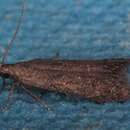pt-BR
nomes no trilho de navegação


Monochroa hornigi, the knotweed neb, is a moth of the family Gelechiidae. It was described by Otto Staudinger in 1883. It is found in most of Europe (except Ireland, Belgium, Luxembourg, Spain and most of the Balkan Peninsula),[1] European Russia, western and south-eastern Siberia, Transbaikalia, Korea and Japan (Hokkaido).[2]
The wingspan is about 9–12 mm.[3] The forewings are dark fuscous, with two black stigmata on the plica and the disc and an ochreous, obliquely narrow, triangular blotch on the apical third of the costa and also on the tornus. There are three ochreous minute dots on the costa between the costal triangular blotch and the apex and three similar dots on the termen. The hindwings are fuscous.[4] Adults are on wing from July to August in one generation per year.[5]
The larvae feed on Polygonum species, including Polygonum lapathifolium and Polygonum aviculare. They mine the stems of their host plant and overwinter in a silken chamber.[6]
Monochroa hornigi, the knotweed neb, is a moth of the family Gelechiidae. It was described by Otto Staudinger in 1883. It is found in most of Europe (except Ireland, Belgium, Luxembourg, Spain and most of the Balkan Peninsula), European Russia, western and south-eastern Siberia, Transbaikalia, Korea and Japan (Hokkaido).
The wingspan is about 9–12 mm. The forewings are dark fuscous, with two black stigmata on the plica and the disc and an ochreous, obliquely narrow, triangular blotch on the apical third of the costa and also on the tornus. There are three ochreous minute dots on the costa between the costal triangular blotch and the apex and three similar dots on the termen. The hindwings are fuscous. Adults are on wing from July to August in one generation per year.
The larvae feed on Polygonum species, including Polygonum lapathifolium and Polygonum aviculare. They mine the stems of their host plant and overwinter in a silken chamber.
De duizendknoopboegsprietmot (Monochroa hornigi) is een vlinder uit de familie tastermotten (Gelechiidae). De wetenschappelijke naam is voor het eerst geldig gepubliceerd in 1883 door Staudinger.
De soort komt voor in Europa.
Bronnen, noten en/of referentiesMonochroa hornigi é uma espécie de insetos lepidópteros, mais especificamente de traças, pertencente à família Gelechiidae.
A autoridade científica da espécie é Staudinger, tendo sido descrita no ano de 1883.
Trata-se de uma espécie presente no território português.
Monochroa hornigi é uma espécie de insetos lepidópteros, mais especificamente de traças, pertencente à família Gelechiidae.
A autoridade científica da espécie é Staudinger, tendo sido descrita no ano de 1883.
Trata-se de uma espécie presente no território português.